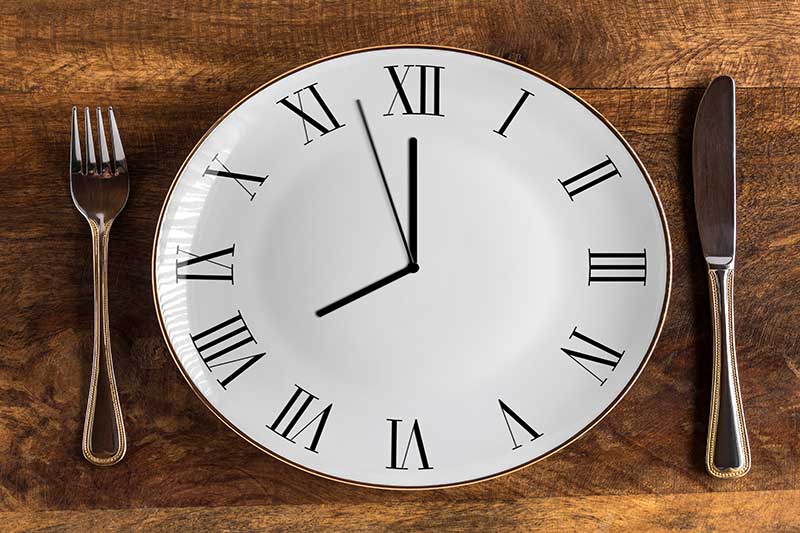Alternating between periods of eating and fasting is more commonly referred to as intermittent fasting, which is quickly becoming a popular weight loss method among people of all ages. Instead of advising you on which foods to stay away from, the system focusses instead on when you should be eating. Although no food is allowed during the fasting process, water, tea, coffee and any other calorie-free drinks are permitted.
Intermittent fasting is something that has become popular in recent years due to the rise is specialist weight loss methods, such as the 5:2 diet. As an extreme form of intermittent fasting, the 5:2 diet has become popular among people trying to lose weight with quick results.
Essentially, everybody has a fasting period daily, while they are asleep. A popular way to carry out intermittent fasting is to extend this time, by eating breakfast a little later in the day than usual, and then eating dinner a little earlier, leaving more time between the two in which to fast. Eating your last meal of the day by 8pm in the evening and then waiting until 12 pm the following day to consume food once more is common and creates a fasting period of 16 hours in-between meals, commonly naming this method the 16/8.
This approach is a relatively simple way to practice intermittent fasting because for a significant amount of this time you will be asleep and, therefore, your body is used to going without food for a good portion of this time. Although initially, you may feel hungry due to not eating as soon as you wake, this is something that the body generally gets used to, and those who achieve fasting this way often report they have more energy and feel better in themselves.
How does intermittent fasting work?
As you eat throughout the day, your body cycles through various states. When digesting and absorbing food, your body is thought to be in a “fed state”, and a “post-absorptive state” refers to when a meal is no longer being processed.
Due to the high insulin level that your body has when processing food, it becomes much harder to burn fat while you are in the fed state. This state can last anything from three to five hours from the time you start eating. When your body is not processing a meal, it is known to be in the post-absorptive state which lasts eight to twelve hours after your last meal. After this amount of time, your body begins to enter the fasted state which is when the body finds it easiest to burn fat, due to the low insulin levels.
Entering a ‘true’ fast state can be difficult as it doesn’t begin until 12 hours after the last time you ate meaning that even the time most people are sleeping for isn’t quite long enough. Intermittent fasting is, therefore, known to affect weight loss even without a change in diet or by upping the amount of exercise you partake in, making it an increasingly popular fat loss method.
Why practice intermittent fasting?
The concept of fasting to humans has already been around for thousands of years, whether that be down to fasting out of necessity when there was little food available, or through a religion encouraging the process of fasting a few times a year. As humans, we have learned from experience that our bodies are more than capable of handling a short period of fasting, therefore, meaning that there is no need to be concerned about adapting it into your everyday lifestyle if you so wish.
Studies suggest that some of the benefits of intermittent fasting include:
- Reduce insulin resistance, lowering risk of type 2 diabetes
- Reduce oxidative stress and inflammation in the body
- Improve blood pressure, total and LDL cholesterol
- Induces various cellular repair processes
- Protects against diseases including heart disease, diabetes, and cancer
How do I start intermittent fasting?
If you are interested in trying intermittent fasting, the 16/8 method can be an easy place to begin. All you need to do is make sure that you are leaving a window of “fasting” between 8pm and 12pm, or for at least 16 hours. This is one of the easiest methods to get started with, due to most people being asleep for a significant portion of this time. You just need to ensure you eat all your meals between 12pm and 8pm.
Here are some tips for getting started:
- Make sure that it’s healthy for your body to be fasting – pregnancy or diabetes are examples of when intermittent fasting isn’t advisable.
- No calorie fluids are still allowed even during fasting periods, so make sure you stay hydrated.
- Finding a method that fits your everyday life style will make the process much easier, and you will find you’re more likely to stick to it this way. Even if this means only intermittent fasting at weekends, or in the week, to begin with, that’s fine!
- Being prepared for the mental and physical shift in your body when you begin the process of fasting is something of importance.
- Be sensible with your meals. However tempted you may be too over indulge when 12 pm comes, you must keep your meals and food intake how they normally would be. If you are over eating, then you will end up counteracting the benefits of the fast.
Although it is possible to see results from intermittent fasting without adapting your food intake to a healthier diet, the best results will be seen if carried out alongside healthy food choices and exercise regime. As with any new diet, you should seek advice from a medical professional before starting to ensure it’s safe for you.
As with all diets, intermittent fasting is best practiced alongside exercise. If you’re looking to reduce stress, yoga is an excellent choice. Before you begin, get comfortable yoga clothes from a favorite yoga shop.

